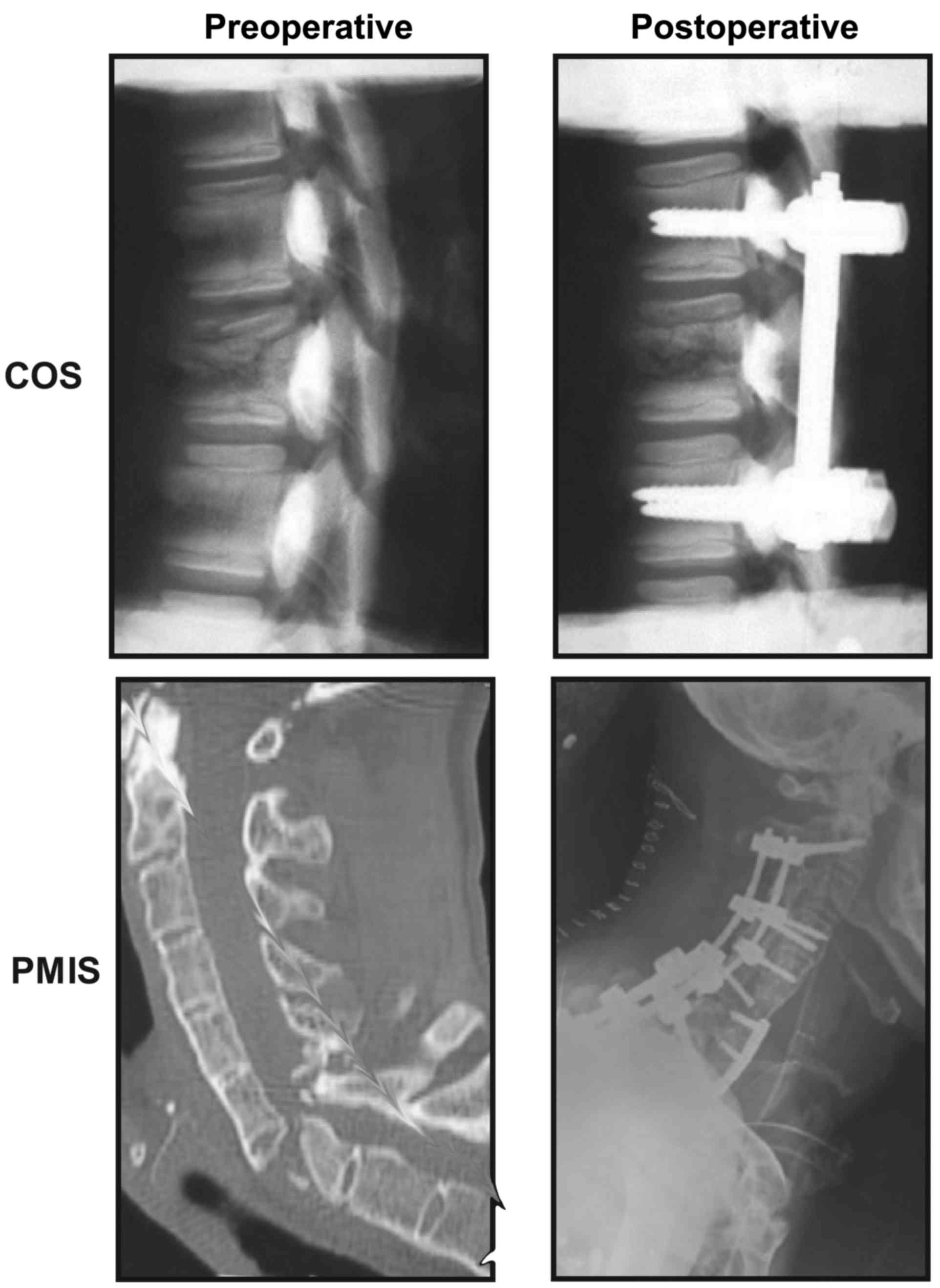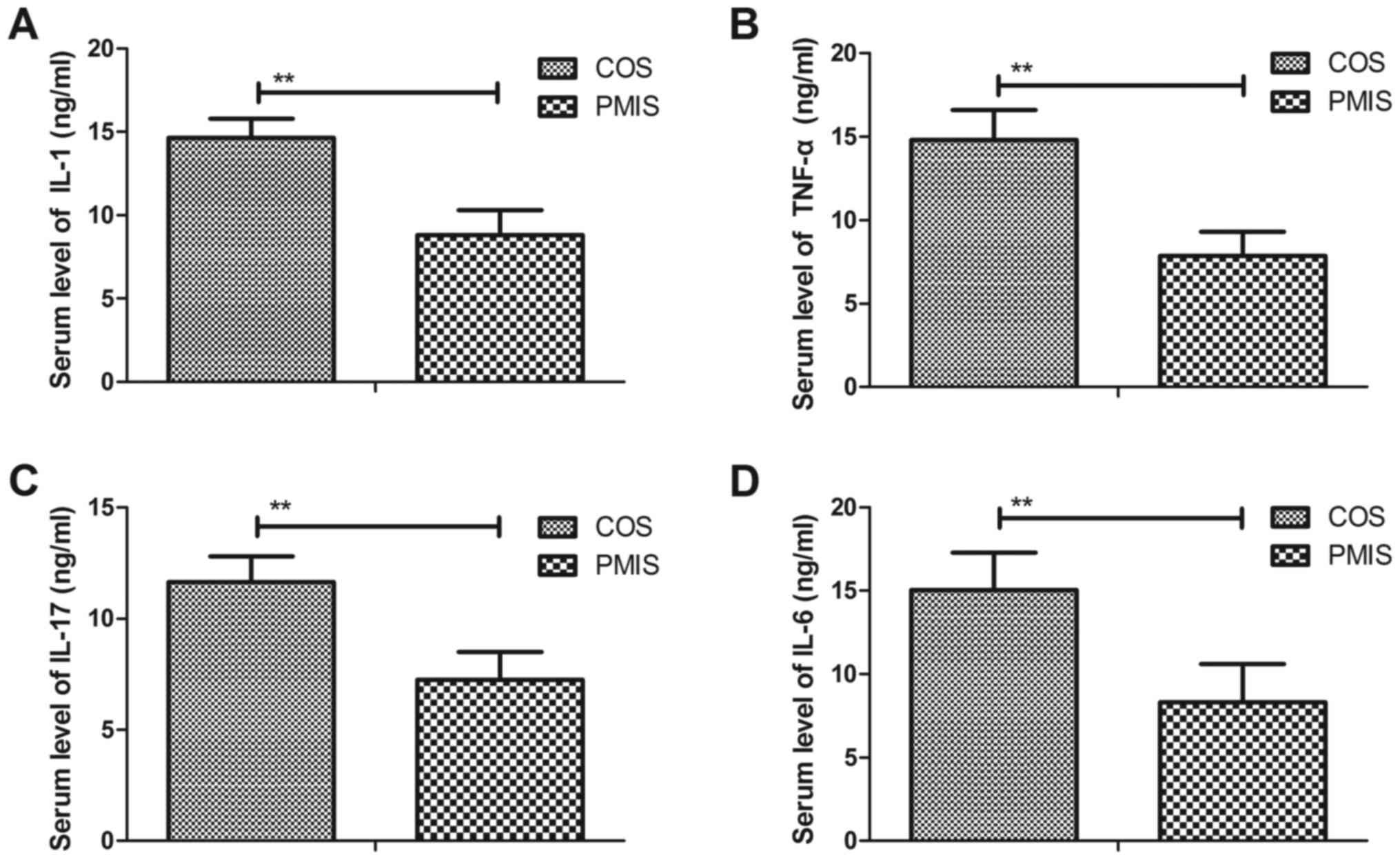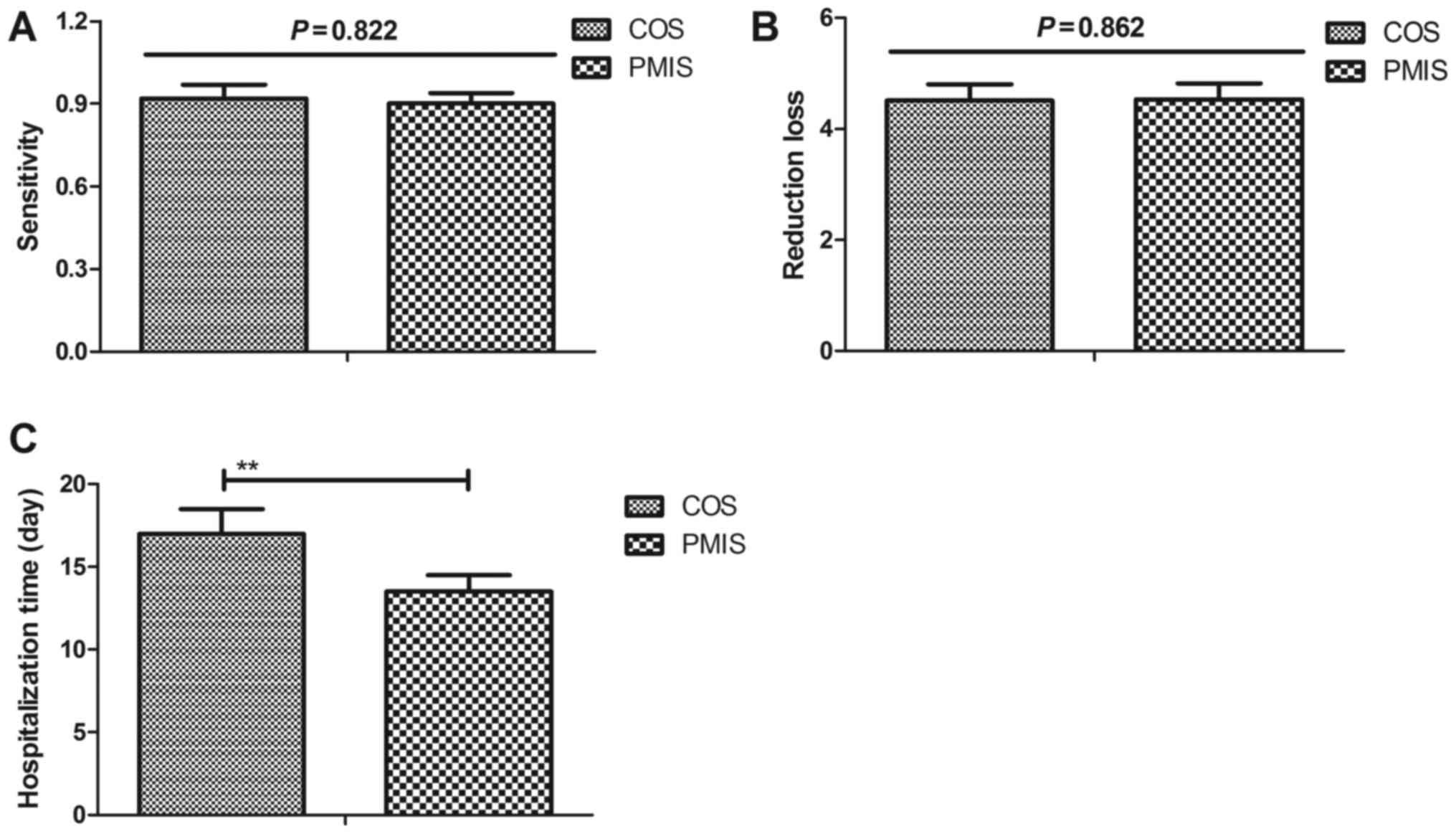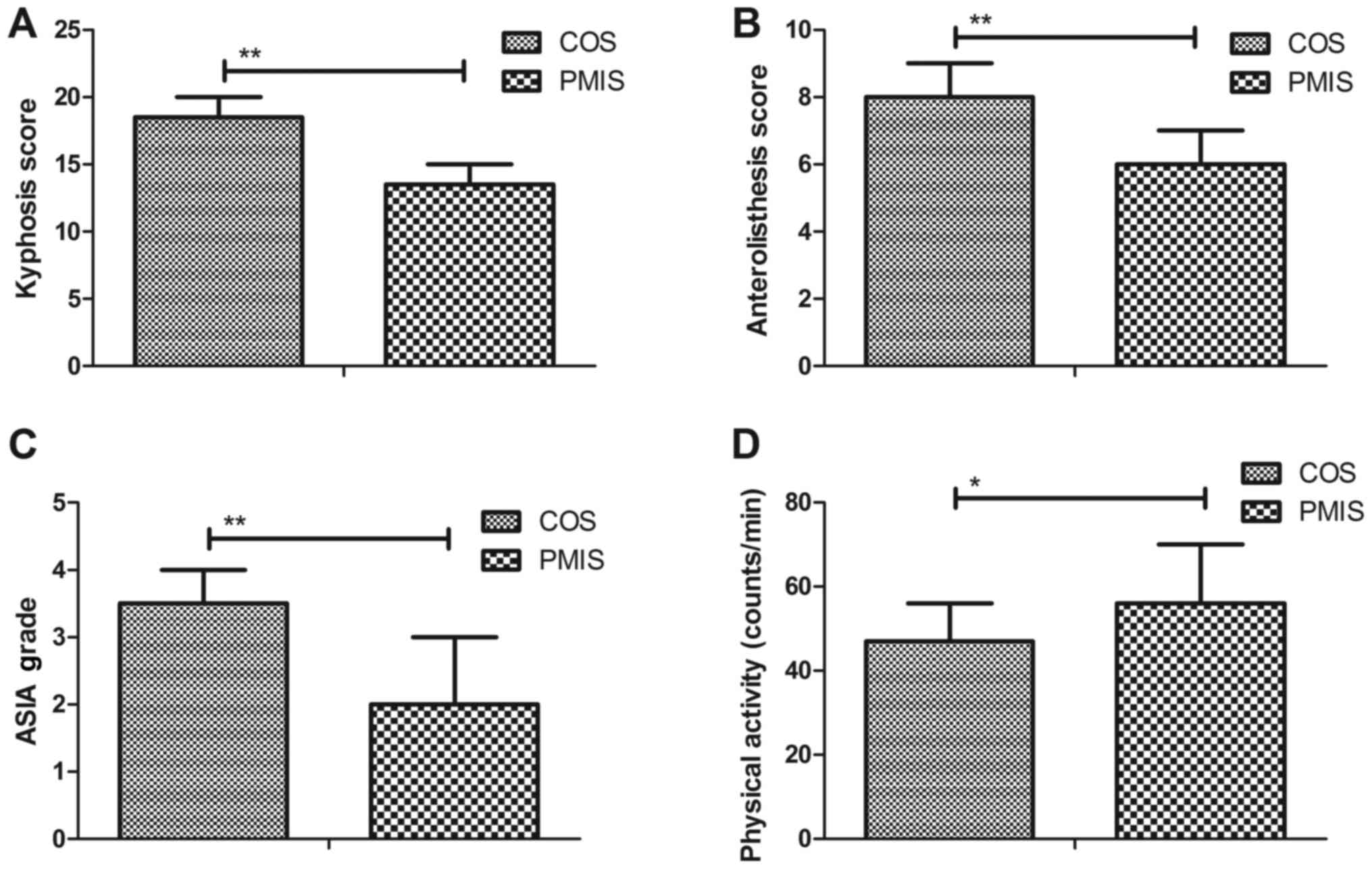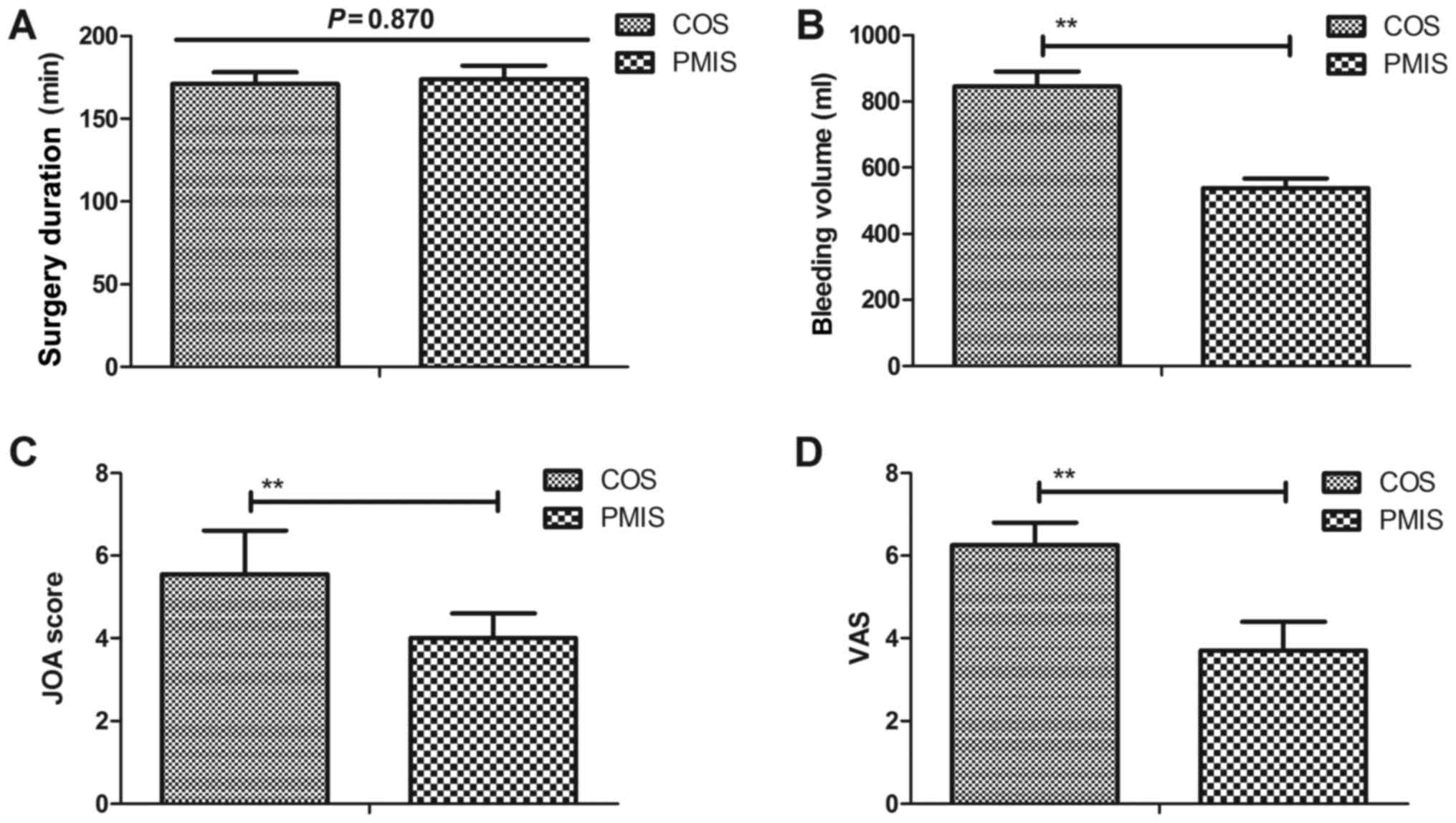|
1
|
Beisse R and Verdú-López F: Current status
of thoracoscopic surgery for thoracic and lumbar spine. Part
1General aspects and treatment of fractures. Neurocirugia (Astur).
25:8–19. 2014.
|
|
2
|
Božík M, Magala M, Heger T, Matejička D,
Baka J and Šimko P: Pedicle screw fixation of thoracic spine
fractures. Acta Chir Orthop Traumatol Cech. 81:140–151. 2014.(In
Slovak). PubMed/NCBI
|
|
3
|
van der Jagt-Willems HC, van Munster BC,
Tulner LR and Lems WF: Geriatricians should screen for vertebral
fractures in all individuals by performing X-rays of the thoracic
spine. J Am Geriatr Soc. 62:2027–2029. 2014. View Article : Google Scholar : PubMed/NCBI
|
|
4
|
Singh R, McD Taylor D, D'Souza D, Gorelik
A, Page P and Phal P: Injuries significantly associated with
thoracic spine fractures: A case-control study. Emerg Med
Australas. 21:419–423. 2009.PubMed/NCBI
|
|
5
|
Gross EA: Computed tomographic screening
for thoracic and lumbar fractures: Is spine reformatting necessary?
Am J Emerg Med. 28:73–75. 2010. View Article : Google Scholar : PubMed/NCBI
|
|
6
|
Ulmar B, Gühring M, Stuby F, Brunner A,
Schmälzle T, Weise K and Badke A: Traumatic thoracic spine
fractures: Inter- and intraobserver reliability of vertebral, local
and segmental kyphosis in lateral X-rays. Z Orthop Unfall.
147:481–486. 2009.(In German). View Article : Google Scholar : PubMed/NCBI
|
|
7
|
Rosengart TK, Feldman T, Borger MA,
Vassiliades TA Jr, Gillinov AM, Hoercher KJ, Vahanian A, Bonow RO
and O'Neill W; American Heart Association Council on Cardiovascular
Surgery and Anesthesia, ; et al Percutaneous and minimally invasive
valve procedures: A scientific statement from the American Heart
Association Council on Cardiovascular Surgery and Anesthesia,
council on clinical cardiology, functional genomics and
translational biology interdisciplinary working group, and quality
of care and outcomes research interdisciplinary working group.
Circulation. 117:1750–1767. 2008. View Article : Google Scholar : PubMed/NCBI
|
|
8
|
Raffa GM, Pellegrini C, Lentini S,
Perrotta S, Tancredi F, Gaeta R and Viganò M: Minimally invasive
video-assisted surgery for iatrogenic aortic root-to-right atrium
fistula after incomplete percutaneous occlusion of patent foramen
ovale: Case report and review of the literature. J Card Surg.
23:75–78. 2008. View Article : Google Scholar : PubMed/NCBI
|
|
9
|
Ohuchi H, Kyo S, Asano H, Tanabe H, Yokote
Y and Omoto R: Development and clinical application of minimally
invasive cardiac surgery using percutaneous cardiopulmonary
support. Jpn J Thorac Cardiovasc Surg. 48:562–567. 2000. View Article : Google Scholar : PubMed/NCBI
|
|
10
|
Deo SV, Sharma V, Shah IK, Erwin PJ, Joyce
LD and Park SJ: Minimally invasive direct coronary artery bypass
graft surgery or percutaneous coronary intervention for proximal
left anterior descending artery stenosis: A meta-analysis. Ann
Thorac Surg. 97:2056–2065. 2014. View Article : Google Scholar : PubMed/NCBI
|
|
11
|
Kwan MK, Lee CK and Chan CY: Minimally
invasive spinal stabilization using fluoroscopic-guided
percutaneous screws as a form of palliative surgery in patients
with spinal metastasis. Asian Spine J. 10:99–110. 2016. View Article : Google Scholar : PubMed/NCBI
|
|
12
|
Barbagallo GM, Yoder E, Dettori JR and
Albanese V: Percutaneous minimally invasive versus open spine
surgery in the treatment of fractures of the thoracolumbar
junction: A comparative effectiveness review. Evid Based Spine Care
J. 3:43–49. 2012.PubMed/NCBI
|
|
13
|
Takami M, Yamada H, Nohda K and Yoshida M:
A minimally invasive surgery combining temporary percutaneous
pedicle screw fixation without fusion and vertebroplasty with
transpedicular intracorporeal hydroxyapatite blocks grafting for
fresh thoracolumbar burst fractures: prospective study. Eur J
Orthop Surg Traumatol. 24 Suppl 1:S159–S165. 2014. View Article : Google Scholar : PubMed/NCBI
|
|
14
|
Tu KK, Zhou XT, Tao ZS, Chen WK, Huang ZL,
Sun T, Zhou Q and Yang L: Minimally invasive surgical technique:
Percutaneous external fixation combined with titanium elastic nails
for selective treatment of tibial fractures. Injury. 46:2428–2432.
2015. View Article : Google Scholar : PubMed/NCBI
|
|
15
|
Napier RJ and Nolan PC: Diagnosis of
vertebral fractures in post-ictal patients. Emerg Med J.
28:169–170. 2011. View Article : Google Scholar : PubMed/NCBI
|
|
16
|
Pavon JM, Sanders LL, Sloane R and
Colón-Emeric C: Sensitivity of osteoporosis screening guidelines
for eventual hip fracture in older male veterans. Bonekey Rep.
3:5302014. View Article : Google Scholar : PubMed/NCBI
|
|
17
|
Kataoka H, Ikemoto T, Yoshimura A, Shibuya
M, Goto K, Yamashita J, Morita K, Sakamoto J, Nakano J and Okita M:
Association of early physical activity time with pain, activities
of daily living, and progression of vertebral body collapse in
patients with vertebral compression fractures. Eur J Phys Rehabil
Med. 53:366–376. 2017.PubMed/NCBI
|
|
18
|
Rahbek O, Jensen SL, Lind M, Penny JØ,
Kallemose T, Jakobsen T and Troelsen A: Inferior reliability of VAS
scoring compared with International Society of the Knee reporting
system for abstract assessment. Dan Med J. 64(pii):
A53462017.PubMed/NCBI
|
|
19
|
Yonenobu K, Abumi K, Nagata K, Taketomi E
and Ueyama K: Interobserver and intraobserver reliability of the
japanese orthopaedic association scoring system for evaluation of
cervical compression myelopathy. Spine (Phila Pa 1976).
26:1890–1895. 2001. View Article : Google Scholar : PubMed/NCBI
|
|
20
|
Payer M, Smoll NR, Oezkan N and Tessitore
E: Dynamic transpedicular stabilisation and decompression in
single-level degenerative anterolisthesis and stenosis. Acta
Neurochir (Wien). 156:221–227. 2014. View Article : Google Scholar : PubMed/NCBI
|
|
21
|
van Middendorp JJ, Hosman AJ, Pouw MH;
EM-SCI Study Group, ; Van de Meent H: ASIA impairment scale
conversion in traumatic SCI: is it related with the ability to
walk? A descriptive comparison with functional ambulation outcome
measures in 273 patients. Spinal Cord. 47:555–560. 2009. View Article : Google Scholar : PubMed/NCBI
|
|
22
|
Ippolito E, Farsetti P, Boyce AM, Corsi A,
De Maio F and Collins MT: Radiographic classification of coronal
plane femoral deformities in polyostotic fibrous dysplasia. Clin
Orthop Relat Res. 472:1558–1567. 2014. View Article : Google Scholar : PubMed/NCBI
|
|
23
|
Bartley CE, Bastrom TP and Newton PO:
Blood loss reduction during surgical correction of adolescent
idiopathic scoliosis utilizing an ultrasonic bone scalpel. Spine
Deform. 2:285–290. 2014. View Article : Google Scholar : PubMed/NCBI
|
|
24
|
Kreinest M, Schmahl D, Grützner PA and
Matschke S: Trisegmental fusion by vertebral body replacement:
Outcome following traumatic multisegmental fractures of the
thoracic and lumbar spine. Unfallchirurg. 121:300–305. 2018.(In
German). PubMed/NCBI
|
|
25
|
Linhares D, Neves N, Ribeiro da Silva M
and Almeida Fonseca J: Analysis of the cochrane review: Pedicle
screw fixation for traumatic fractures of the thoracic and lumbar
spine. Cochrane database syst rev. 2013;05:CD009073. Acta Med Port.
29:297–300. 2016.(In Portuguese).
|
|
26
|
Chiu KM, Lin TY, Chen JS and Chu SH:
Percutaneous cardioplegia delivery using the miniport in minimally
invasive mitral valve surgery. Interact Cardiovasc Thorac Surg.
7:342–343. 2008. View Article : Google Scholar : PubMed/NCBI
|
|
27
|
Zhang W, Li H, Zhou Y, Wang J, Chu T,
Zheng W, Chen B and Li C: Minimally invasive posterior
decompression combined with percutaneous pedicle screw fixation for
the treatment of thoracolumbar fractures with neurological
deficits: A prospective randomized study versus traditional open
posterior surgery. Spine (Phila Pa 1976). 41 Suppl 19:B23–B29.
2016. View Article : Google Scholar : PubMed/NCBI
|
|
28
|
Zeng BF: Minimally invasive surgery in
fracture management. Chin Med J (Engl). 121:1349–1351.
2008.PubMed/NCBI
|
|
29
|
Pan YW, Wang XM and Pei XQ: Treatment of
children supracondylar fracture of humerus with minimally invasive
surgery. Zhongguo Gu Shang. 22:3432009.(In Chinese). PubMed/NCBI
|
|
30
|
Wen J, Xu G, Du C and Wang B: Minimally
invasive percutaneous nephrolithotomy versus endoscopic combined
intrarenal surgery with flexible ureteroscope for partial staghorn
calculi: A randomised controlled trial. Int J Surg. 28:22–27. 2016.
View Article : Google Scholar : PubMed/NCBI
|
|
31
|
Wei FC: Minimally invasive surgery for
vertebral fracture and spinal infection. Biomed J. 36:1532013.
View Article : Google Scholar : PubMed/NCBI
|
|
32
|
Jing ZF, Zhao YY, Wang RG, Wang GZ and
Teng LL: Minimally invasive surgery to treat severe
acromioclavicular dislocation combined with coracoid process
fracture. Zhongguo Gu Shang. 23:46–48. 2010.PubMed/NCBI
|
|
33
|
Hu YM and Pang QJ: Effectiveness of
manipulative reduction combined with minimally invasive surgery in
the treatment of osteoporotic vertebral compression fracture: A
meta-analysis. Zhongguo Gu Shang. 28:1042–1047. 2015.PubMed/NCBI
|
|
34
|
Wang J, Zhou Y, Zhang ZF, Li CQ, Zheng WJ
and Huang B: Minimally invasive transforaminal interbody fusion
surgery for the old fracture of the thoracolumbar junction. J
Spinal Disord Tech. 27:E55–E60. 2014. View Article : Google Scholar : PubMed/NCBI
|



